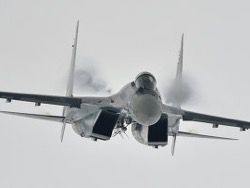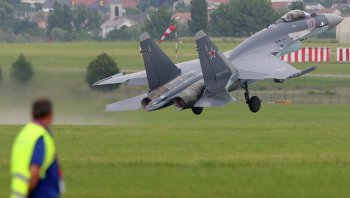F-15 against Su-35: who will win?

The fighter F-15C Eagle (Eagle) which is let out by the Boeing company, is on arms of military and air forces of the USA here about 40 years and, apparently, will be used within several decades. For these years powerful F-15 it is constantly modernized taking into account growing threats, but whether respectable "Eagle" (Eagle) possesses those qualities which are necessary for a domination gain in the sky?
The answer will be such: yes – it is absolute. "Eagle", probably, is not so young, however F-15 still remains to one of the best fighters for achievement of an air superiority. By the unique operating plane surpassing F-15 in the majority of indicators, the fighter F-22 Raptor made by the Lockheed Martin company is – other cars possess advantage in some aspects, however F-15C, as a whole, keeps competitiveness whatever representatives of customer departments of various competing contractors spoke about it.

Possibly, the most serious threat for F-15 is represented by the Russian fighter Dry Su-35 (Flanker-E). Though other planes representing big danger, are today in a development stage, they, possibly, will appear too expensive to mass production. The fighter Su-35 is not the most widespread potential threat, chances of however are very great that their quantity will quickly grow. According to available data, Indonesia decided to buy Su-35 planes, and, besides, we know that Chinese discuss a question of its possible acquisition.
Su-35 is, actually, the dangerous fighting vehicle, and on many parameters does not concede the Russian plane to the most last updatings F-15 or even surpasses them. From the point of view of purely kinematic possibilities, Su-35 loses in the maximum speed F-15 a little, however it surpasses "Eagle" in acceleration that (Product 117С) is reached thanks to its powerful coupled Saturn engines, each of which creates draft in 14500 kg. Besides, when this plane has rather small loading, it is capable to keep supersonic speed, without resorting to use of forsazhny chambers.
Though magnificent acceleration at big heights till supersonic speed is huge advantage, to the fighter F-15C too to eat than answer – and as a result the similar superiority of the Russian plane will not be solving. However on low speeds Su-35 has insuperable advantage. It possesses a vector of draft operated in three measurements and improbable maneuverability on low speeds. However use of nashlemny systems of display and an aiming, and also such rockets with big at глами as AIM-9X and Russian R-73 at close visual contact will lead targetings to a situation of «mutual destruction» (mutual kill) to what many pilots testify, more often. At the same time will many depend on ability of the pilot and if it is honest, from good luck.
If to speak about more considerable radiuses of action, F-15C and F-15E still have a superiority over Su-35 that is caused by their radar with the active phased antenna lattice (active electronically scanned array radar). The radar of Raytheon APG-63 (v) 3 and APG-82 (v) 1 established on both "Eagles", still considerably surpasses in the possibilities "tikhomirovsky" radar station with Irbis-E’s passive phased antenna lattice with which Su-35 are equipped. The Russian fighter while, really, has insignificant advantage in the field of passive sensors as possesses the built-in infra-red optiko-lokatsionny system of search and support, however F-15 planes will receive very perfect system of search and support already in the near future that will nullify Russian "Flanker’s" advantage.

In one Su-35E area, apparently, holds a superiority – it is a question of means of radio-electronic fight. Su-35С can brag of powerful digital system of radio-electronic suppression with technology of digital storing which is capable to confuse the American AIM-120 AMRAAM rocket. Though these American rockets finally possibly, can overcome protection of the Russian plane, more rockets for purpose destruction is required, than military schedulers counted. Besides, Su-35 can have onboard a huge arsenal of rockets air-air whereas at F-15 it is equipped with obsolete defensive electronics. Military and air forces of the USA perfectly realize existence of this problem and for this reason a lot of attention is given to the project of modernization of system passively / the active prevention and a survival (EPAWSS) for F-15 for which it is supposed to spend 7,6 billion dollars.
The real dilemma consists that Su-35 and the modern F-15 Eagle models are comparable – and it causes concern in the management of Military and air forces of the USA. The American pilots got used to conducting combat operations in a situation when they possess a huge technological superiority whereas in a case with Su-35 of such superiority is not present, and in certain respects "Flanker-E" even surpasses "Eagle". As a whole, other things being equal, even completely modernized F-15C and equipped with the latest radar with the active phased antenna lattice it will be compelled to use all the possibilities in an antagonism with Su-35. However the similar situation would mean that the United States wage war against Russia or against any other great power – such as China. But this, in itself, is improbable.
More possibly that F-15 can face Su-35 which is adopted at any despot from the third world. However pilots of the similar despot will possess hardly preparation, tactics and the experience, necessary to combat against the American pilots and consequently they will have no real chances of a victory. Besides, the Russian fighters, as we know, do not differ special reliability and if to it to add badly prepared technicians and lack of spare parts, any Third World country will not be constantly capable to support the fighter in a due condition. Important also that the potential opponent – short of Russia and China, – most likely, will have no system АВАКС and high-grade land complexes of interception that will create for them additional problems.
Result: if not to consider option of participation F-15 during the third world war, military and air forces of the country, possibly, will use "Eagles" within two decades. Probably, that unilateral advantage to which military and air forces of the country got used, any more will not be, but, nevertheless, air superiority loss yet does not threaten the United States.










